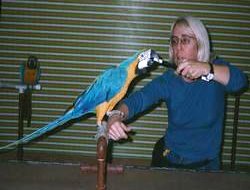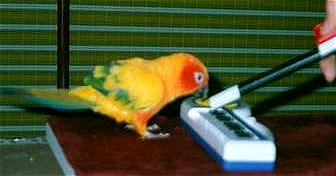
To teach targeting, the bird must first be conditioned to the clicker, which means that he knows that click=reward, or since I use food, I will say that click=treat (C/T).
If you wish to lean more about clickers and clicker training, please read my previous article Trick Training and Its Benefits -Try Clicker Training.
Then we need to decide what to use for the target. The target does not have to be a stick shaped object. But if it is, it cannot be the same hand held perch that you use to have the bird step up on. The target, like any other prop, should only be used for training sessions or demonstrations. We don’t let the birds play with the props during other times, or they lose their meaning. I prefer to teach this from a t-stand or training perch first so the bird can’t wander. This helps to focus his attention on the target.
We start by holding the target near the bird and C/T for any movement toward the target. Then withold the reward until the bird actually touches the target and C/T.
I teach him to touch it with a gentle grip of the beak as the bird will have a tendency to open his beak to touch it. If you have a bird that is very aggressive and wants to grab the object out of your hand, then you will need to hold onto the target and not let him pull it out of your hand. The first time he does a gentle grab C/T with extra treats and praise. This is commonly called a “jackpot”. He should soon get the idea of the gentle grip. Once he understands that, only C/T for gentle grip touches.

The benefits of teaching a bird to target with a gentle grip, is that grabbing something with his beak is natural for him.
We can use this to our advantage if we want to lead him to a prop that we want the bird to pick up. We “target” him to the prop, then remove the target and see if the bird will grab the prop. If he doesn’t we simply back up a couple of steps. Once the bird knows to grab the prop, we don’t need to use the target. We have then used another tool of training and that is generalizing.
If the bird is cage bound, we can start target training in the cage.You may have to take more time to do this, but no need to rush things.It is best when doing it this way, to empty the food bowl and then when you C/T, you simply drop the treats into the food cup. Just remember to refill the bowl when you are finished with your training session.
Once a cage bound or aggressive bird has learned to target, you can start teaching him to step up using the target. I don’t recommend using your arm first to step up on if there is any chance of getting bitten. In training, we ALWAYS avoid bites. Use a hand held perch for the bird to step up on. You can either hold the clicker on the target stick and the perch with the other hand or use a mouth click (like used for horses). Hold the target where he will have to step onto the perch to reach the target. Take your time and don’t worry if you have to back up. We don’t want to frighten the bird. As the bird becomes better at stepping up, you can then teach behaviors away from the cage.
Targeting is just one of the tools we use in training. The important things to keep in mind about this behavior are:
- The basic idea of targeting is to have the bird follow an object to touch it.
- Once he has the idea of the gentle grip only reward him for that.
- Always C/T for every gentle grip of the target.
- Use jackpots to help keep up his interest.
- Try and end sessions on a positive note.
- Have fun, keep training simple and never train if you are in a bad mood.
Once a bird has learned a behavior, he won’t forget it.
Happy training.

